Quality ‘cascade’ can optimise water treatment on mines
According to Peter Shepherd, partner and principal hydrologist at SRK Consulting, the mining sector’s drive towards ambitious water conservation targets means recycling more – so that less fresh water needs to be procured. There is also a financial benefit to recycling, as having to treat water before use or discharge is an expensive exercise. Shepherd highlighted that treatment can be kept to a minimum if mines are clear about what level of water cleanliness is required by its different on-mine processes. “Clearly, a mine does not want to be using potable water to mix with tailings for pumping to a tailings storage facility,” said Shepherd. “Most of a mine’s water will generally be used in the process plant, and these applications can usually manage with much lower water qualities.”
That said, there would be specific phases of the plant that require cleaner water – for the mixing of reagents and chemicals, for instance. There is also a need for water that is low in sediment particles for use in the gland seals of pumps. Mines can therefore optimise the reuse and recycling of their water through developing a water quality ‘cascade’, explained Bjanka Korb, principal environmental engineer at SRK Consulting. This will detail the minimum water quality demanded by each process, so that water is not treated to higher levels of quality that are needed at the point of use. “This approach opens the door to increasing the volumes that can be reused and recycled,” said Korb. “The accumulation of water in the system and resultant discharge of low-quality water into the environment is thereby also minimised.”
An additional benefit is that the mine would be able to reduce its reliance on treated municipal water and therefore the operational cost to the mine could also be decreased. Where untreated dam water can be procured from a municipal source, the mine could use this directly in the plant – and only treat water to potable standards that is used in bathrooms, kitchens and drinking use.
Korb pointed out, however, that with more extensive reuse of water, the water quality within the mine system can deteriorate to the point where regular intervention is required. This is a consequence that must be carefully managed. “Fortunately, most regions have seasonal rainfall which assists with keeping the water quality cleaner,” she said, “however, concentration of salts will occur over time regardless of this, and the reality is that mines may need to consider water treatment for recycled water in the later stages of the life of the mine.”
Developing the cascade approach needs a good understanding of the water and salt balance within the broader system – including the mine workings, the processing circuit, the tailings dam, the fresh water supply and the receiving watercourses. “By identifying the major drivers of water use, a mine can better target its recycling efforts,” said Korb. “For instance, if the water being returned from the tailings dam is sediment-laden or there are other elements within the water that do not easily settle out, then it may not be usable in certain key plant processes.”
Achieving the best results from a water quality cascade relies on good communication between the management of the mine’s process plant and its tailings facility. Plant managers, who know the water volumes and qualities required from day to day, are important players in determining whether the process water demand can be fulfilled by return water from the tailings dam. The communication is vital as the tailings return water dams are often where most of the mine’s water is stored. “The process plant and tailings teams together can assist significantly in managing the mine’s water balance, and in helping reduce the volumes of water being procured externally,” Korb said.
Shepherd noted that leading mining companies have recently begun appointing dedicated experts to focus on water stewardship, to ensure that strategies are implemented and coordinated mine-wide to conserve water use. This, he said, was a positive step towards balancing a mine’s need for optimal recoveries in the plant, with the need to reduce water consumption from external sources.









